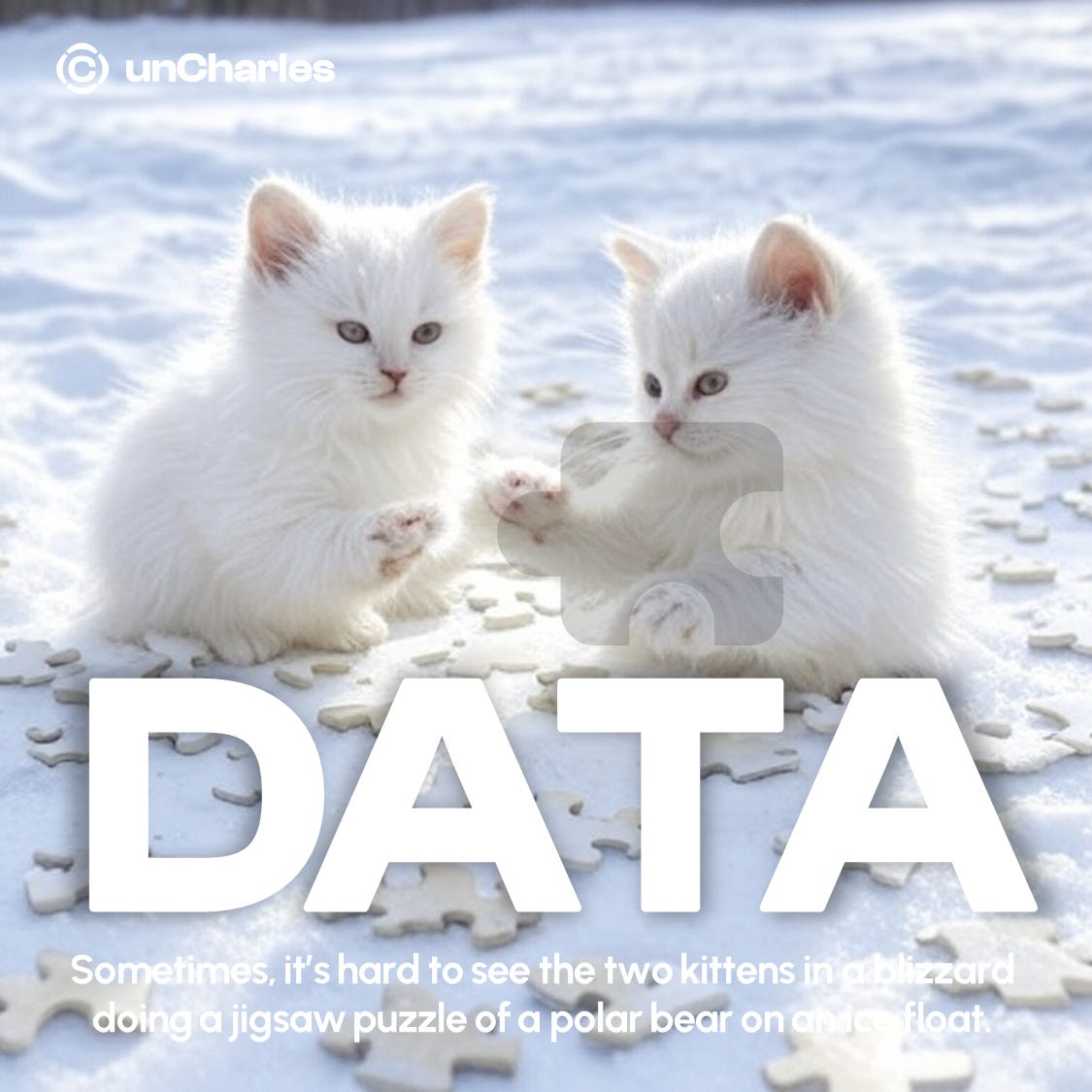Stairway to data
Yes, there are two cats. You can go back, but in the long run, there’s still time to change the float you’re on.
What is this?
This is one of the billions of complex pieces of information that underlies what makes modern media hard. A placeholder for the likes, shares, views, and touches that feed the insatiable systems that power what we see.
Beyond noticing that it looks like a jigsaw puzzle piece, at best, your guess at the big picture would probably be Zo-So. Unless you happen to be a data scientist. In which case, you could extrapolate a ginormously detailed picture and offer up a wealth of insights from the few ones that exist amidst a spare matrix of zeros. That’s data lingo for being able to do a jigsaw puzzle without a box cover image and without edge pieces. That’s how my friend, Rod, explained it to me. Rod is a data scientist. He advises big media companies and, sometimes, the companies that advertise on their platforms.
Rod tells me he’s never wrong, “Not in real time, anyway.” Mostly, because, “Business higherups don’t have the box cover image either.” A funny data scientist. Who knew?
So, I asked Rod what we were looking it. After studying it for a bit and using what I think was an AI-infused slide rule, he told me. “IT’S WHIPPED CREAM ON TOP OF A VANILLA MILKSHAKE SERVED IN A TALL GLASS ON A RED SPECKLED FORMICA COUNTERTOP IN A 1950s ERA MALT SHOP.” I thought, hoo boy! That’s some powerfully specific detail.
It’s these kinds of monetizable details voiced with borderline god-complex swagger that gets clients to pay him with the kind of oversized novelty checks Ed McMahon would bring people who won the Publishers Clearing House sweepstakes. I felt like that kid in the 1969 Tootsie Pop commercial who asked the owl how many licks it took to get to the center.
Then, he started to chuckle. “To guess is human, to divine takes a data scientist. That’s my tagline. I should have called my consultancy, Divining Rod. But I don’t market.”
Not long ago, a friend of his did some work for a small, regional client that was struggling to interpret the results of a brand-lift ad campaign they ran on one of the Meta platforms. In people terms, those ads are supposed to get people to recall the name of your brand either with or without prompting. Unprompted would be, “Did you see ads today?” And the person exposed to the ad would say, “Oh, yes. There was this great ad for Foobar.” The prompted version would ask, “Did you see any foofy ads recently?” The ability to recall a brand leads to more sales. Or, so the story goes.
Meta’s automated data analysis showed a 22.4% brand lift. And that 24.8% of people were likely to buy the now-recalled branded product. I thought, hot damn! That’s some powerfully specific answer.
Having done this for long enough to be jaded, Rod thinks the whole thing is a “bunch of crap.” He wondered out loud if Meta skewed the data – at a data scientist bar. Which is a lot like mentioning the Monty Hall problem in roomful of mathematicians. A raging debate ensued. “It’s not impossible if you believe in your targeting.” Then, stuff about, “Randomization resulting in unbiased group creation.” There was the canard about surveys being notoriously unreliable.
He went on and on but I stopped taking notes and, not long after, stopped listening. At least until he offered up the kind of simple explanation that I crave. Like how Star Trek explains space-time distortions the way a vacuum sucks up carpets without decent adhesive backing.
“It’s like this. A bunch of data scientists bashed the data Musk’s coder kids supposedly found in the social security database.”
If you haven’t been following it, Musk claims the feds paid out loads of money to people who were 150 years old. The crack fact-checking team at Polifact debunked it saying, “Arcane coding practices” explain how 150-year-old receive checks.
Polifact explained, “You see, it’s like this. Social security runs on COBOL, which does not use a date or time type. So the date is stored as a number using the ISO 8601 standard. The epoch for this is 150 years ago (1875) - aka the metre standard. So if you don’t know the date of something, it will be a 0 value, which in COBOL will default to 1875 - 150 years ago.” And, I thought, well, golly gee willikers! That’s some powerfully detailed explanation. COBOL, 0 value, epoch, ISO, and such. Polifact got these details from this post on X by ToshiHQ.
Then, Rod explained how data science really works. “You make stuff up with so much detail that its complexity attracts the people who want to echo important-sounding answers and scares away people who might want to argue with you.”
He continued.
“This has nothing to do with COBOL or ISO 8601 standards. If you don’t know the date… that someone was born… in the social security system… that makes payments… based on a person’s date of birth… you don’t have a coding problem. You have a data problem. Which leads to a thinking problem.”
Huh.
“There’s always a tell in the data. Here is the tell in the Polifact story. In 2021, the Inspector General found $298M in payments to dead people. Only about $84M was returned. Only?!? They’re making payments to dead people. And, two-thirds of the dead people kept the money. You want to figure out the leak — find the dead people.”
Oh.
“The next time you see a politician from the other side repeat a clearly stupid conspiracy theory…Give him/her/they a break. It's hard to come up with new undebunked (bunked?) conspiracy theories with legs.”
He closed with this.
“Oh, and by the way, you don’t have a picture of whipped cream on a shake. You have a cat. And, since it’s jigsaw puzzle, it’s a cat or a couple of cats in a snow storm.”
Well, actually, it’s two kittens in a blizzard doing a jigsaw puzzle of a polar bear.





